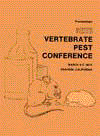Vertebrate Pest Conference Proceedings collection
Date of this Version
March 1974
Document Type
Article
Abstract
A maximum of 500 strychnine eggs were placed in designated skunk habitat within a three mile radius where rabid skunks were diagnosed as an emergency control method to reduce or prevent the spread of rabies in striped skunk (Mephitis mephitis) populations in Northeastern Montana. The effects of strychnine on skunk and other non-target species populations were evaluated. When placed in primary skunk habitat, the toxicant eggs were selective in removing striped skunks. Scent post surveys indicated that skunk populations were reduced, while non-target species populations remained stable or increased in control areas. The effects of the toxicant egg program in reducing the incidence of rabies in striped skunks in Northeastern Montana is not clear after only one year of data. Close surveillance of the emergency skunk control areas in succeeding years may indicate the need for continuation or expansion of similar programs.

